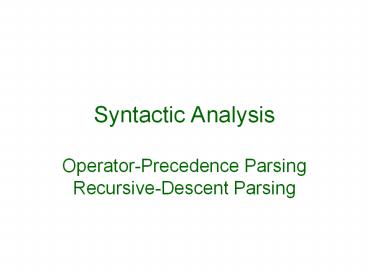Syntactic%20Analysis%20Operator-Precedence%20Parsing%20Recursive-Descent%20Parsing PowerPoint PPT Presentation
Title: Syntactic%20Analysis%20Operator-Precedence%20Parsing%20Recursive-Descent%20Parsing
1
Syntactic AnalysisOperator-Precedence
ParsingRecursive-Descent Parsing
2
Syntactic Analysis
- Syntactic analysis building the parse tree for
the statements being translated - Parse tree
- Root goal grammar rule
- Leaves terminal symbols
- Methods
- Bottom-up operator-precedence parsing
- Top-down recursive-descent parsing
3
Operator-Precedence Parsing
- The operator-precedence method uses the
precedence relation between consecutive operators
to guide the parsing processing. - A B C - D
- Subexpression BC is to be computed first because
has higher precedence than the surrounding
operators, this means that appears at a lower
level than does or in the parse tree. - Precedence
4
Precedence Matrix
Empty means that these two tokens cannot appear
together
5
Example READ ( VALUE )
6
Example VARIANCESUMSQ DIV 100 MEANMEAN
7
Example VARIANCESUMSQ DIV 100 MEANMEAN
8
Shift-Reduce Parsing
- Operator-precedence parsing can deal with the
operator grammars having the property that no
production right side has two adjacent
nonterminals. - Shift-reduce parsing is a more general bottom-up
parsing method for LR(k) grammar. - It makes use of a stack to store tokens that have
not yet been recognized. - Actions
- Shift push the current token onto the stack
- Reduce recognize symbols on top of the stack
according to a grammar rule.
9
Example READ ( VALUE )
10
Recursive-Descent Parsing
- A recursive-descent parser is made up of a
procedure for each nonterminal symbol in the
grammar. - The procedure attempts to find a substring of the
input that can be interpreted as the nonterminal. - The procedure may call other procedures, or even
itself recursively, to search for other
nonterminals. - The procedure must decide which alternative in
the grammar rule to use by examining the next
input token. - Top-down parsers cannot be directly used with a
grammar containing immediate left recursion.
11
Modified Grammar without Left Recursion
still recursive, but a chain of calls
always consume at least one token
12
- check_prog()
- if( get_token()PROGRAM
- check_prog-name()true
- get_token()VAR
- check_dec-list()true
- get_token()BEGIN
- check_stmt-list()true
- get_token()END.)
- return(true)
- else
- return(false)
13
- check_for()
- if( get_token()FOR
- check_index-exp()true
- get_token()DO
- check_body()true)
- return(true)
- else
- return(false)
14
- check_stmt()
- / Resolve alternatives by look-ahead /
- if( next_token()id )
- return check_assign()
- if( next_token()READ )
- return check_read()
- if( next_token()WRITE )
- return check_write()
- if( next_token()FOR )
- return check_for()
15
Left Recursive
- 3 ltdec-listgtltdecgtltdec-listgtltdecgt
- 3a ltdec-listgtltdecgtltdecgt
- check_dec-list()
- flagtrue
- if(check_dec()false)
- flagfalse
- while(next_token())
- get_token()
- if(check_dec()false)
- flagfalse
- return flag
16
- 10 ltexpgtlttermgtltexpgtlttermgtltexpgt-lttermgt
- 10a ltexpgtlttermgtlttermgt-lttermgt
- check_exp()
- flagtrue
- if(check_term()false)
- flagfalse
- while(next_token() or next_token()-)
- get_token()
- if(check_term()false)
- flagfalse
- return flag
17
- check_prog()
- if( get_token()PROGRAM
- check_prog-name()true
- get_token()VAR
- check_dec-list()true
- get_token()BEGIN
- check_stmt-list()true
- get_token()END.)
- return(true)
- else
- return(false)
18
Recursive-Descent Procedure for READ Statement
19
- check_read()
- if( get_token()READ
- get_token()(
- check_id-list()true
- get_token()))
- return(true)
- else
- return(false)
20
Example READ ( VALUE )
21
Recursive-Descent Procedure for Assignment
Statement
22
Recursive-Descent Procedure for Assignment
Statement
23
Example VARIANCESUMSQ DIV 100 MEANMEAN
24
Code Generation
- When the parser recognizes a portion of the
source program according to some rule of the
grammar, the corresponding semantic routine (code
generation routine) is executed. - As an example, symbolic representation of the
object code for a SIC/XE machine is generated. - Two data structures are used for working storage
- A list (associated with a variable LISTCOUNT)
- A stack
25
- SUM,SUMQ,I,VALUE,MEAN,VARIANCEINTEGER
- SUM WORD 0
- SUMQ WORD 0
- I WORD 0
- VALUE WORD 0
- MEAN WORD 0
- VARIANCE WORD 0
- SUM0
- LDA 0
- STA SUM
- SUMSUMVALUE
- LDA SUM
- ADD VALUE
- STA SUM
26
- VARIANCE SUMQ DIV 100 MEAN MEAN
- TEMP1 WORD 0
- TEMP2 WORD 0
- TEMP3 WORD 0
- LDA SUMQ
- DIV 100
- STA TEMP1
- LDA MEAN
- MUL MEAN
- STA TEMP2
- LDA TEMP1
- SUB TEMP2
- STA TEMP3
- LDA TEMP3
- STA VARIANCE
- TEMP WORD 0
- LDA MEAN
- MUL MEAN
- STA TEMP
- LDA SUMQ
- DIV 100
- SUB TEMP
- STA VARIANCE
27
Example READ ( VALUE )
placed in register L
Argument passing
28
Example VARIANCESUMSQ DIV 100 MEANMEAN
29
Example VARIANCESUMSQ DIV 100 MEANMEAN
30
Other Code-Generation Routines
31
Other Code-Generation Routines
32
(No Transcript)

